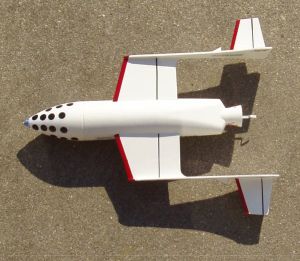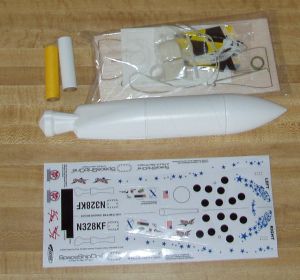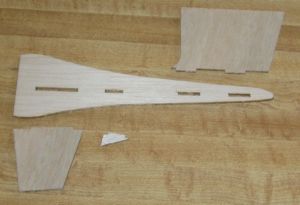| Construction Rating: | starstarstarstar_borderstar_border |
| Flight Rating: | starstarstarstarstar_border |
| Overall Rating: | starstarstarstarstar_border |

Brief:
After many months with breathless anticipation, the Estes SpaceShipOne finally arrived. This kit is a 1/30th sport-scale kit based on a BT-200 tube, which is 2" in diameter. This was the first time I noticed the SS1 being attributed to Mojave Aerospace Ventures vs. Scaled Composites. There are some issues for the scale fans out there. For instance, if you look at the rear nozzle, it looks like the test flight configuration, however, the markings appear to be those on the final X-Prize flight. Still, the resulting kit looks pretty sweet and I'm really glad Estes got it out.
Construction:
The kit includes:

- Motor mount, including an 18mm tube, engine block, engine hook, Mylar retainer ring
- Long plastic tail cone with nozzle
- BT-200 body tube
- Plastic nose cone
- Laser cut balsa fins
- Die cut cardboard centering rings and wing assembly fixture
- Launch lug, 1/8"
- Rubber shock cord, 1/4" x 18"
- Assembled 12" plastic chute
- Clay nose weight
- Lots of peel and stick decals
Recommended supplies for construction: scissors, pencil, ruler, sandpaper, carpenter's glue, tube-type plastic cement, modeling knife, razor saw, masking tape, white primer, white and red spray paint, and (optional) gloss coat.
The first step is to assemble the motor mount. This is a typical build and consists of the BT-20 motor mount, two centering rings, an engine hook, a Mylar retainer for the hook, and a motor block. I used carpenter's glue as recommended. Be careful when attaching the centering rings as they are oblong and have to be aligned properly.
Next, I removed and sanded the fins then filled them with Elmer's Fill 'n' Finish. It was nice having the laser cut fins for this model since the various fin components are aligned via slots cut in the long vertical fins. These precise cuts really help ensure the proper alignment of these parts. However, the cuts were not all the way through the balsa and the bottom side must be cut with a hobby knife. The most challenging aspect of the fins is that the root edge has to be beveled 60 degrees. A reference guide is provided, but I found it challenging to get the angle right along the length of the fin. A slicker modeler would no doubt have or come up with a jig to simplify this step.
 I attached all the fins with Aileen's Tacky Glue starting with the side fins, then the long vertical fins, and finally the side fins. I am glad Estes provided the wing assembly fixture, however, with a tad more cardboard they could have provided one that actually supports the wings. This would not be a cost driver. I had thought the fins were set, when I decided to go up to bed. This was a mistake as the fins sagged a bit by morning.
I attached all the fins with Aileen's Tacky Glue starting with the side fins, then the long vertical fins, and finally the side fins. I am glad Estes provided the wing assembly fixture, however, with a tad more cardboard they could have provided one that actually supports the wings. This would not be a cost driver. I had thought the fins were set, when I decided to go up to bed. This was a mistake as the fins sagged a bit by morning.
The tail cone is capped on both ends and thus must be trimmed using a razor saw. The instructions say to use plastic cement to glue the mount into the tail cone, but I substituted Gorilla Glue (sparingly) in its place. Before installation in the main body tube, I epoxied a two-foot section of Kevlar® twine onto the mount through the top ring. I also attached the tail cone to the body tube using 5-minute epoxy in place of the recommended plastic glue.
The final touches included the launch lug, adding the clay nose weight, and tying the Kevlar® to the rubber band and the latter to the nose cone.
Finishing:
Finishing was typical: fill, prime, paint, add decals, cover with a clear coat, etc. For this model, this process was a mistake! My usual finishing techniques moved the CG about 1/2" aft, which is not a good thing on this rocket. More about this later.
The model is mostly white with red trim on the leading edge of the fins and the bottom tip of the nose cone. There isn't guidance on the exact color or the location of the red areas, so a scale aficionado will want to do some research here. Personally, I eyeballed it using the picture on the package and my cardstock SSI model. I also opted for brush on paint vs. the recommended red spray paint.
The decals are self-adhesive and the material seemed fine. However, the precision of the cuts was so-so. For example, some of the star pattern seemed to be missed when the patterns were cut. A bottom view of the model would have helped in positioning the decals. To end on a positive note, I am glad the decals were peel and stick instead of waterslide. I undoubtedly would have ruined a couple had they been the latter.
I think the resulting kit looks nice, but even though I am not a scale fanatic, it bugged be that there was a mismatch between the nozzle configuration and the markings and that there was not better guidance on how to position the decals. At first, I was going to really ding the kit based on the fact that finishing the fins using normal techniques can make the model unstable. However, anyone who has bought and flown the kit doesn't need my rating, and anyone who hasn't bought or built it now knows how to fix the problem. So, I decided to ignore stability issues.
Construction Rating: 3 out of 5
Flight:
Now, back to the question of stability. There was much discussion about stability on The Rocketry Forum (do a search for SS1 stability). Rather than repeat lots of information here, I will just say that Estes now recommends adding an additional ½ oz of nose weight.
The recommended motors include the B4-2, B6-2, and C6-3. Due to the size and weight of the model, I opted for a C6-3. The instructions do say to launch with "little or no wind." When I launched it, the wind was about 5 mph. The model weather cocked a bit but not badly. The added weight did the trick even with my method of finishing the fins and the wind.
Recovery:
I used the stock chute and the model recovered without significant damage on soft, plowed ground. There were small stress cracks where the fins were attached to the plastic tail cone, but it is flyable as is. Maybe this is due to my use of Aileen's Tacky Glue? On the next flight, I think I'll use a larger chute.
Flight Rating: 4 out of 5
Summary:
This is a unique kit and despite the scale issues, it looks pretty neat. I am happy to have it in my fleet. Nevertheless, Estes could have done a much better job in the scale details and in making it more flyable. They should have warnings on how to prep the balsa and include the proper nose weight. However, the news about he added nose weight came in time to save my model, so again I am happy.
Overall Rating: 4 out of 5
Other Reviews
- Estes X-Prize SpaceShipOne By Eric Maglio
Brief: This is a scale model of the Scaled Composites SpaceShipOne. It is part of a new line of rockets including many X-Prize kits from Estes. This rocket uses 18mm motors and has a 12" parachute recovery. Construction: The kit comes with a motor mount kit, body tube, nose cone, and a scale tail cone. Also included is the recovery system and laser-cut balsa parts. The ...
 |
 |
Flights
 |
 |
